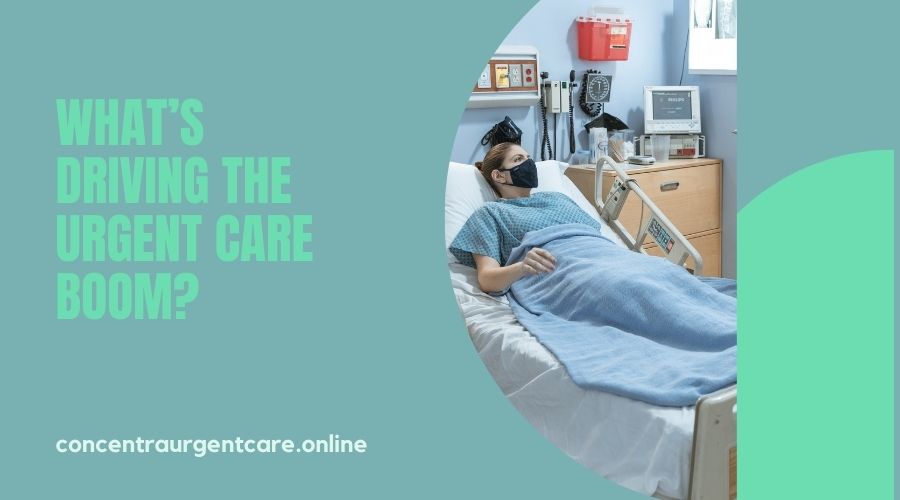What’s Driving the Urgent Care Boom?
Urgent care centers have become a common fixture in many communities, providing quick and convenient medical care for non-emergency conditions. With the rise in demand for these services, it’s important to understand the factors driving the growth of the urgent care industry. From advancements in technology to the aging population and the rise in chronic conditions, there are several key drivers contributing to the growth of urgent care centers.

These centers offer patients a cost-effective alternative to traditional emergency room visits, providing quick access to medical attention without the long wait times and high costs associated with ERs. In this article, we will explore the factors driving the boom in the urgent care industry and answer some frequently asked questions about these centers.
Increased Demand for Convenient Healthcare Services
One of the main factors driving the growth of urgent care centers is the increasing demand for convenient healthcare services. With busy schedules and long wait times at traditional emergency rooms, many patients are seeking alternative options that offer quick and easy access to medical care. Urgent care centers typically have shorter wait times, extended hours, and a wide range of services, making them a convenient option for patients who need medical attention but don’t require emergency room care.
Advancements in Technology
Another factor driving the growth of urgent care centers is advancements in technology. With the use of electronic medical records and telemedicine, urgent care centers are now able to offer more efficient and effective care. This technology not only helps to improve the quality of care but also makes it easier for patients to access their medical records and communicate with their healthcare providers.
Also Read: What is Urgent Care Medicine?
Affordability and Cost-effectiveness
Urgent care centers are also becoming increasingly popular because they offer a cost-effective alternative to traditional emergency room visits. Many insurance plans cover urgent care services, and the cost of these services is typically lower than that of an emergency room visit. For patients who do not have insurance, urgent care centers often offer lower out-of-pocket costs.
The Aging Population
The aging population is another factor driving the growth of urgent care centers. As the population ages, there is an increasing demand for healthcare services. Urgent care centers offer older adults a convenient option for receiving medical care, as they are often closer to their homes and offer extended hours.
The Rise in Chronic Conditions
Finally, the rise in chronic conditions is also driving the growth of urgent care centers. With the increasing prevalence of conditions such as diabetes, heart disease, and hypertension, there is a growing demand for convenient medical care. Urgent care centers offer patients with chronic conditions an option for receiving medical attention when their regular doctor is unavailable.
Also Read: Why Urgent Care is Growing So Fast
FAQs
1. What is an urgent care center?
Urgent care centers are medical facilities that offer walk-in medical services for patients with non-emergency conditions. They are designed to provide a convenient alternative to traditional emergency rooms.
2. What services do urgent care centers offer?
Urgent care centers offer a wide range of services, including diagnosing and treating illnesses and injuries, performing tests and procedures, and prescribing medications.
3. How do the costs of urgent care services compare to those of emergency room services?
Urgent care services are typically less expensive than emergency room services. Many insurance plans cover urgent care services, and the cost of these services is often lower than that of an emergency room visit.
4. What are the hours of operation for urgent care centers?
Urgent care centers typically have extended hours and are open seven days a week. This makes them a convenient option for patients who need medical attention outside of regular office hours.
Are there any downsides to using an urgent care center?
One potential downside to using an urgent care center is that the wait times can be longer than those at a traditional doctor’s office. Additionally, some urgent care centers may not have all of the specialized equipment and services available in a traditional emergency room.
Also Read: Why Are There So Many Emergency Rooms?
Conclusion:
In conclusion, the growth of urgent care centers is being driven by a variety of factors, including increased demand for convenient healthcare services, advancements in technology, affordability and cost-effectiveness, the aging population, and the rise in chronic conditions.
Urgent care centers offer patients a convenient and cost-effective alternative to traditional emergency rooms, providing quick and easy access to medical care for non-emergency conditions. While there may be some downsides to using an urgent care center, such as longer wait times, overall they provide a valuable service for patients in need of medical attention outside of regular office hours.
